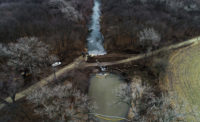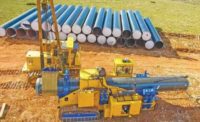The Keystone oil pipeline's four largest spill accidents since operation started in 2010 were caused by issues related to its original design, manufacture or construction, the U.S. Government Accountability Office says in a new report.
The analysis says two the two largest spills in 2017 and 2019 on the 2,687-mile line from Alberta, Canada to Illinois, with a segment south to Gulf Coast terminals, discharged nearly 13,000 barrels of oil in North Dakota and South Dakota. These dropped the line's safety ranking to "worse than the nationwide average" from 2015 to 2020, although most of its other 16 spills since 2010 were 50 barrels or less.
Based in part on experience overseeing Keystone's operation, the U.S. Dept. of Transportation’s Pipeline and Hazardous Materials Safety Administration has increased inspections during construction of other pipelines and is establishing a more formal process to document and track compliance with all special permits, according to the Aug. 23 report.
The agency sets and enforces standards for design, construction, operation, maintenance and inspection of interstate pipelines that transport hazardous liquids and natural gas. It issued a special permit for Keystone to operate at higher stress levels than would otherwise be permitted because the line used pipe made of higher-grade steel.
Pipelines normally operate at 72% of maximum operating pressure of specified minimum yield strength, above which a steel pipeline will begin to deform, the report says. The special permit allows keystone owner, Calgary, Alberta-based TC Energy Corp., to operate at 80% of that strength along two sections. The higher-grade steel used for Keystone segments allows for thinner but stronger pipeline walls and reduced overall steel material expense, says GAO. TC Energy said in its application for the special permit that the move would reduce steel costs by about 10%.
Since operation began, Keystone has transported over 3 billion barrels of crude oil to refineries in Illinois, Oklahoma and Texas, in a dense and highly viscous form called bitumen that is derived from oil sands .
The special permit applies to two pipeline segments— a 1,025-mile, 30-in. main line from the Canadian border at North Dakota to Illinois, and a 291-mile, 36-in. extension from Nebraska to Oklahoma.
The report did not include Keystone's Gulf Coast extension or the small portion of the $9-billion Keystone XL expansion built at the U.S. border. That project, which was set to triple the volume of oil carried, was terminated in June by TC Energy after President Joe Biden cancelled its cross border permit on Jan. 20. The firm has filed a $15-billion cancellation claim under the NAFTA trade agreement.
Pipe Strength Questioned
Pipeline accidents can occur for reasons that include construction damage, corrosion, mechanical failure, control system failure and operator error, the report says.
Since 2008, PHMSA has identified pipe manufacturing quality issues across the pipeline industry, including at one or more manufacturers that supplied pipe used to construct Keystone. Some mills had manufactured pipe that failed to meet strength specifications required by regulations, which could cause the steel to deform at pressures lower than intended, and the pipeline to expand as a result.
In 2009, PHMSA issued an advisory bulletin and accompanying guidance, directing operators to use in-line inspection tools to identify pipeline segments with steel that had expanded. After TC Energy completed its inspections, which detected areas with deformed pipe, it excavated and replaced 32 affected pipeline joints in 2016 and it was allowed to operate at the 80% level.
According to the report, two Keystone accidents in South Dakota in 2016 and in 2017 were caused by issues in construction, installation or fabrication of the pipeline, while the 2019 North Dakota accident was caused by defects in the original pipe manufacture.
GAO did not identify project contractors or pipeline manufacturers.
At one South Dakota site, analysis showed that the design of the pipeline system did not adequately take into account vibrations that occur at pump stations, causing station components to fail as a result, the report says.
At another site, the girth weld joining two pipe segments of differing thicknesses failed and caused a leak. A fatigue crack at the third site likely was caused by damage to the pipe exterior by a vehicle during installation that grew to a critical size.
At the North Dakota site, the pipe was manufactured with an atypical seam weld geometry severe enough to cause a fatigue crack, GAO says.
PHMSA reported that corrosion was the leading cause of accidents impacting people or the environment by pipelines carrying crude oil, refined oil products or biofuels from 2010 to 2020, accounting for 30% of such events. But corrosion was not the cause of any of the severe Keystone spills.
PHMSA also said from 2010 to 2020, 12% of all such accidents were caused by a material failure of the pipe, such as defects in steel material or in welds used in manufacturing or in joining sections during construction. By comparison, half of Keystone accidents impacting people or the environment were caused by material failure of pipe or weld.
Oversight Agency Staff Boosted
PHMSA told GAO that it has increased the amount of staff it devotes to inspecting pipelines under construction. The agency said inspectors spent 351 inspection days on site during Keystone’s construction, from June 2008 to November 2010.
PHMSA did not issue any formal enforcement actions to TC Energy during construction, but officials said inspectors brought up issues that were addressed at the construction site, such as improper welds and weld inspections.
To address common issues such as poor quality control for welding and inadequate construction practices that PHMSA had identified across 35 pipeline projects in the 2008 construction season, the agency now expects each project inspector to spend 20% to 25% of time on construction inspections. That has doubled the number of days inspectors have spent on construction inspections since 2010, the report says.
PHMSA also developed additional conditions as a result of “lessons learned” from construction and operation of the Keystone pipeline, including implementing a construction quality management system that includes hiring an independent third-party inspector to monitor construction.
In response to its findings, TC Energy told GAO that it now uses a comprehensive third-party review of its pipeline integrity program.
“We have also leaned heavily into development and utilization of new technology," said Leslie Kass, executive vice president in a response to GAO. "For example, our engineering team helped develop an advanced inspection validation tool and next-generation crack detection technology that expands our ability to detect minute pipeline imperfections.”
TC Energy has had "zero high-impact incidents occurring in the past 18 months," Kass said.






Post a comment to this article
Report Abusive Comment